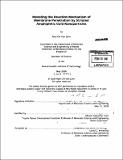Modeling the reaction mechanism of membrane penetration by striated amphiphitic gold nanoparticles
Author(s)
Van Lehn, Reid Chi
DownloadFull printable version (5.329Mb)
Other Contributors
Massachusetts Institute of Technology. Dept. of Materials Science and Engineering.
Advisor
Alfredo Alexander-Katz.
Terms of use
Metadata
Show full item recordAbstract
The desire to desire targeted drug delivery devices capable of releasing therapeutic payloads within the cytosol of cells has led to research on nanoparticles as suitable drug carriers. Recently, it was shown that gold nanoparticles coated in striped, alternating layers of hydrophobic and hydrophilic ligands are capable of non-disruptively penetrating a lipid bilayer, a discovery with potential implications in drug delivery. While the reaction mechanism is not known, initial experimental results indicate that endocytosis and membrane poration could be ruled as possible mechanisms. In this work, we explore the reaction mechanism of membrane penetration using a coarse-grained Brownian Dynamics model. We also define a Monte Carlo simulation for modeling ligand motion on the nanoparticle surface based on a single order parameter, and describe a method for approximating the interaction energy with the bilayer as a function of this parameter. Our simulations demonstrate the dependence of nanoparticles penetration on the surface mobility, not explicit conformation, of coated ligands. They demonstrate that while nanoparticles with static ligands in a striped conformation are unable to penetrate the bilayer, enabling surface mobility allows penetration by the induced formation of a small, transient pore of a comparable size to the nanoparticle. Our results offer an enhanced understanding of the nanoparticles-bilayer interaction and an identification of the property necessary for membrane penetration.
Description
Thesis (S.B.)--Massachusetts Institute of Technology, Dept. of Materials Science and Engineering, 2009. Cataloged from PDF version of thesis. Includes bibliographical references (p. 37-38).
Date issued
2009Department
Massachusetts Institute of Technology. Department of Materials Science and EngineeringPublisher
Massachusetts Institute of Technology
Keywords
Materials Science and Engineering.